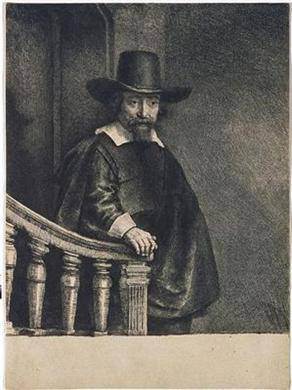
Rembrandt – Ephraim Bonus, Jewish Physician
Christie’s announce auction of Old Master, Modern and Contemporary Prints, September 2010 Alongside iconic prints by Andy Warhol, Roy Lichtenstein, Pablo Picasso and Joan Miro, the sale will also feature more unusual works by Richard Hamilton, Anish Kapoor, William Kentridge and Sigmar Polke. With estimates ranging from £2,000 up to £300,000 the sale offers something for a wide range of tastes and budgets.]]>
August 23rd 2010, source: Christie’s
Contemporary Prints
Highlighting the contemporary section is a group of works from the estate of the late Ernie Donagh (1941-2007), one of the most accomplished printers of his generation. A specialist in the complex art of stone lithography, he worked for Editions Alecto and Petersburg Press, who pioneered the publication of editions in the 1960s. During his career, Donagh worked with many of the great British and American artists of the post-war era, including Richard Hamilton, Jim Dine, David Hockney and Frank Stella, amongst others. Many of the prints in Donagh’s collection were given to him by the artists and have never been on the market, including Richard Hamilton’s Toaster (estimate: £10,000-15,000), Fashion Plate (estimate: £15,000-20,000) illustrated above right, and I’m Dreaming of a Black Christmas (estimate: £12,000-16,000), Frank Stella’s Jasper’s Dilemma (estimate: £5,000-7,000) and David Hockney’s Grimm’s Fairy Tales (estimate: £6,000-8,000).
Modern Prints
Leading the modern section are a set of lithographs by Marc Chagall, Four Tales from the Arabian Nights (estimate: £200,000-300,000), some illustrated top, and Henri Matisse’s album Jazz (estimate: £100,000- 150,000), 3 of 20 illustrated below, two of the greatest works of colour printmaking of the 20th century.
Marc Chagall, who in the eyes of many was the pre-eminent colour lithographer of his age, began his relationship with the medium with Four Tales from the Arabian Nights. The Arabian Nights, more accurately known as the One Thousand and One Nights, is a collection of Middle Eastern and South Asian stories and folk tales compiled during the Islamic Golden Age in Arabic. The stories were told night after night by Scheherazade, the new bride of a Persian king, in an effort to postpone the threat of her pending execution. Arabian Nights has come to be regarded as one of Chagall’s greatest achievements in the medium, in large part because the literary source was ideally suited to the artist’s lyrical style, his opulent colour palette and his boundless imagination.
Matisse had first used a paper cut-out design in an early issue of the renowned journal Verve, yet when the publisher Tériade suggested an entire book based on cut-outs, the artist refused. However, after some persuasion and further thoughts and experiments with the printing technique, Matisse changed his mind and threw all his energy into the project. When he presented the book to Tériade, it was already with the – seemingly unrelated – title Jazz, as he associated the bold cut-out forms and vibrant colours of the work with the rhythms and dynamism of Jazz music. The publication of the book in 1947 was an unprecedented success. Jazz, like Chagall’s Arabian Nights, is an example of what a great artist and printmaker can achieve when subject, style and the respective technique, in this case pochoir, are perfectly matched.
Old Masters Prints
The section of Old Master Prints comprises some fine prints by Goya, Piranesi and Tiepolo, as well as a rare, large woodcut-frieze of An Army Train by Erhard Schön (estimate: £8,000-12,000), yet it is dominated by a group of portraits by Rembrandt. The two most remarkable impressions are those of Ephraim Bonus, Jewish Physician (estimate: £25,000-35,000), and of the Artist’s Mother seated at a table, looking right, (estimate: £6,000-8,000).
Ephraim Bonus, or Bueno as he was really named, came from a prominent Sephardic family of doctors in Amsterdam. Bueno himself worked as a medical doctor, but also wrote poetry, translated Spanish text and belonged to the same literary circles as Rembrandt’s friends. While Rembrandt usually drafted his portraits straight onto the printing plate, there is a small oil sketch in the Rijksmuseum, which must have been a preparatory work for the portrait of Bueno. Perhaps he did not know the sitter very well and needed the oil sketch as an aide-memoire. In any case, Rembrandt altered the image significantly on the printing plate; while on the oil sketch the sitter looks directly at us, in the print his right eye is looking elsewhere. It is this shy, introspective glance that – despite his formal, confident pose at the foot of the stairs – lends Bueno an air of melancholy and humility, a quality that unites the finest of Rembrandt’s portrait etchings.
Quite naturally, the portrait of the Artist’s Mother conveys an even stronger sense of intimacy. Unlike with Bueno, Rembrandt appears to have worked directly onto the plate. He thereby concentrated entirely on the face and the hands, lovingly recording the wrinkles and creases of his mother’s aged skin with the finest lines. This is the quintessential portrait of an artist’s mother, and it is rare to find good early impressions such as the present one, with the delicate lines and the darkest, heavily worked areas printed with such clarity.
Follow us on:

